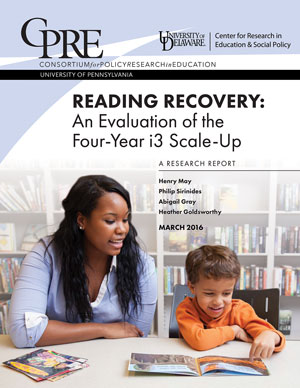Evaluation of the i3 Scale-up of Reading Recovery reports
Final independent research report finds i3 scale-up of Reading Recovery ‘highly successful’
Innovation in Intervention: Replicating the Success of Reading Recovery
In this podcast, CPRE senior researchers Henry May, Abigail Gray, and Philip Sirinides discuss their monumental study of Reading Recovery and how their results could be used to inform and monitor future developments in education. Their paper, “The Impacts of Reading Recovery at Scale: Results From the 4-Year i3 External Evaluation,” was published in Educational Evaluation and Policy Analysis in March 2018.
4-Year Evaluation of Reading Recovery Expansion Finds Strong Gains in Student Reading Achievement
March 17, 2016
University of Pennsylvania Graduate School of Education
Findings from “one of the most ambitious and well-documented expansions of an instructional program in U.S. history” show the $55 million Investing in Innovation (i3) scale-up of Reading Recovery was highly successful.
Reading Recovery: An Evaluation of the Four-Year i3 Scale-Up by the Consortium for Policy Research in Education (CPRE) reports key findings on scale-up processes, challenges, and outcomes; immediate and sustained impacts; implementation fidelity, and implementation at both the lesson and school level. The independent evaluation examining Reading Recovery’s “impacts and execution is one of the most comprehensive evaluations ever implemented in the field of education.”
The randomized control trial (RCT) study of immediate impacts in the scale-up schools—among the largest such studies ever conducted—revealed medium to large impacts across all outcome measures. Effect sizes at the end of 12- to 20-weeks of treatment ranged between 0.30 and 0.42 standard deviations.
“The growth rate we observed in students who participated in Reading Recovery over approximately a five-month period was 131 percent of the national average rate for 1st-grade students. Moreover, these results were similar in two subgroups of interest to the i3 program: English Language Learners and students in rural schools.” (p. 3)
A total of 3,747 teachers were trained, serving 61,992 students in one-to-one lessons. In addition, these Reading Recovery-trained professionals taught 325,458 students in classroom or small-group instruction.
Background
In October 2010, the USDE awarded a 5-year, $45.6 million Investing in Innovation (i3) grant to The Ohio State University. An additional $9.1 million required private sector match was also raised to support Reading Recovery training across the United States. All 19 Reading Recovery university training centers in the U.S. partnered in the project.
These funds supported year-long Reading Recovery training for teachers. Although all U.S. schools were eligible for the professional development funding provided by the i3 grant, particular priority was given to very low-performing schools, schools in rural areas, and schools with high populations of English language learners. The Consortium for Policy Research in Education (CPRE) was contracted to conduct an independent evaluation of the i3 scale up of Reading Recovery over the course of 5 years.
About CPRE
The Consortium for Policy Research in Education (CPRE) brought together experts from major research universities to improve elementary and secondary education by bridging the gap between educational policy and student learning. CPRE’s member institutions are the University of Pennsylvania, Teachers College Columbia University, Harvard University, Stanford University, University of Michigan, University of Wisconsin-Madison and Northwestern University. The report was a collaboration between CPRE and the University of Delaware Center for Research in Education and Social Policy (CRESP).
THE JOURNAL OF READING RECOVERY
Spring 2024
Constructing a More Complex Neural Network for Working on Written Language That Learns to Extend Itself by Carol A. Lyons
Reading Recovery IS the Science(s) of Reading and the Art of Teaching by Debra Semm Rich
Predictions of Progress: Charting, Adjusting, and Shaping Individual Lessons by Janice Van Dyke and Melissa Wilde
Teachers Designing for Context: Using Integrity Principles to Design Early Literacy Support in Aotearoa New Zealand by Rebecca Jesson, Judy Aitken, and Yu Liu


